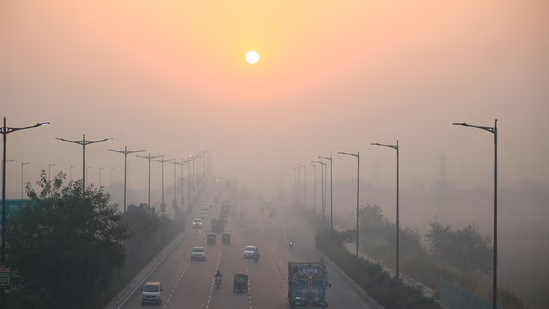
Delhi continues to battle dangerously high levels of air pollution, with the Air Quality Index (AQI) registering in the “very poor” category on Sunday. The city’s AQI reached 334, as reported by the Central Pollution Control Board (CPCB). Several key areas, including Alipur, Anand Vihar, Jahangirpuri, Rohini, and Bawana, experienced hazardous air conditions, contributing to the city’s ongoing air quality crisis.
Areas With Severe AQI Levels
Data from SAFAR-India revealed alarming figures from various parts of Delhi. Bawana recorded an AQI of 383, making it one of the most polluted areas, while Anand Vihar trailed with 351. Other notable readings included 341 in Dwarka Sector 8, 394 in New Moti Bagh, and 368 in RK Puram. The IGI Airport and ITO areas also registered levels of 326 and 328, respectively. Meanwhile, India Gate, a major landmark, was shrouded in thick smog with an AQI of 357.
Even high-rise buildings in areas like Kalindi Kunj were engulfed by haze, with levels around 323. Mundka, Wazirpur, Najafgarh, and Okhla Phase-2 also registered levels well above 300, categorizing them under “very poor” conditions. The AQI scale categorizes air quality as follows: 0-50 is considered “good,” 51-100 is “satisfactory,” 101-200 is “moderate,” 201-300 is “poor,” 301-400 is “very poor,” and 401-500 is “severe.”
The Causes Behind Air Pollution Surge
Delhi’s deteriorating air quality is being attributed to a combination of factors. Stubble-burning in neighboring states, residual pollution from Diwali celebrations, and stagnant air due to low wind speeds have created a toxic blend. This has resulted in nearly two consecutive weeks of unhealthy air across the city. Experts believe that while stubble-burning in regions such as Punjab and Haryana remains a critical issue, weather conditions have further worsened the situation, trapping pollutants close to the ground.
In addition to stubble-burning, vehicular emissions, construction dust, and industrial activities within the capital have significantly contributed to the worsening air quality. The persistent smog has now prompted health warnings, particularly for vulnerable populations such as children, the elderly, and individuals with pre-existing respiratory conditions.
Impact on Public Health
The hazardous air quality has sparked concerns among health professionals. Residents across the city, including those without a history of respiratory issues, have reported breathing difficulties, eye irritation, and throat discomfort. Prolonged exposure to such high levels of pollution is especially dangerous, with health experts warning of the potential for long-term respiratory diseases.
Individuals are being advised to stay indoors, use air purifiers, and wear N95 masks when venturing outside. Schools and offices have also begun implementing measures to mitigate exposure to the toxic air, including shifting to virtual work and study arrangements where possible.
A Smog-Covered Capital
The dense smog hanging is becoming an all-too-familiar sight for its residents. Visuals from Kartavya Path showed thick clouds of smog obscuring India Gate, a reminder of the severity of the pollution. Similarly, other parts of the capital, such as Kalindi Kunj and its surrounding areas, are also grappling with the same hazy conditions.
This week, air quality conditions remained firmly in the “very poor” category, with the AQI touching 358 earlier. For the past several days, pollution levels have hovered around these critical numbers, putting a significant strain on the city’s healthcare system as more people report respiratory problems.
Calls for Urgent Action
Environmentalists and public health officials are urging immediate action to address chronic air pollution issues. While temporary measures such as banning construction activities and limiting vehicular traffic have been imposed, experts say that a more sustainable, long-term solution is essential to prevent the capital from becoming a perennial victim of toxic air.
Efforts to reduce stubble-burning, regulate industrial emissions, and promote cleaner transportation options are just a few of the many strategies that experts believe can help tackle the root causes of Delhi’s pollution crisis. Without substantial intervention, Delhi may continue to face poor air quality in the foreseeable future, putting the health and well-being of millions at risk.
In summary, Delhi’s air pollution crisis has shown no signs of abating, with the city grappling with hazardous levels of smog. The recent spike has been exacerbated by a combination of stubble-burning, post-Diwali pollution, and unfavorable weather conditions. Public health remains a top concern as residents are urged to take precautions to minimize their exposure to the toxic air.